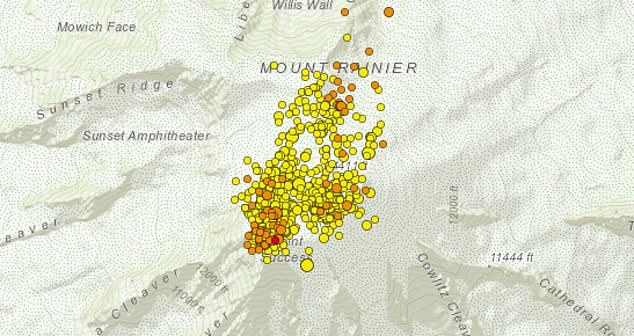
Volcano Threatening 3 Million Americans Hit by 800 Earthquakes; Experts Monitor Eruption Risk
Mount Rainier’s Earthquake Swarm Sparks Volcanic Concerns
[Image: Mount Rainier with earthquake graph caption: Nearly 800 earthquakes have struck the volcano in 30 days.]
Mount Rainier, Washington’s iconic stratovolcano, has experienced nearly 800 earthquakes in the past month—over 500 in July alone. A single 12-hour swarm accounted for 400 tremors, raising fears that one of America’s most dangerous volcanoes could reawaken. Though no major eruption has occurred in 1,000 years, seismic activity of this scale often signals volcanic unrest. The volcano looms over 3.3 million residents in Seattle, Tacoma, and Portland, with lahars—deadly, fast-moving mudflows—posing the greatest threat.
USGS Urges Calm Amid Rising Anxiety
The U.S. Geological Survey (USGS) attributes the tremors to hot fluid movements beneath the surface, not magma, and maintains the volcano’s alert level at “Green/Normal.” “There’s no indication of imminent eruption,” they stated, noting most quakes were too weak to be felt. However, volcanologists warn Rainier’s eventual eruption is inevitable. “It keeps me up at night,” admitted Jess Phoenix of the Union of Concerned Scientists. “Communities here are built on ancient mudflows from past eruptions.”
The Lahar Threat: A Silent Killer
[Image: Simulation of a lahar engulfing a town; caption: Lahars can devastate regions within minutes.]
Unlike lava or ash, lahars—volcanic mudflows—are Rainier’s deadliest hazard. Triggered by eruptions melting glaciers or heavy rains, these walls of debris can obliterate everything in their path. Tacoma and Seattle sit atop 100-foot-thick deposits from ancient lahars. A modern example is the 1985 Armero tragedy in Colombia, where a lahar killed 25,000 people overnight. Closer to home, Mount St. Helens’ 1980 eruption unleashed destructive lahars, claiming 57 lives.
Monitoring and Preparedness
While current quakes haven’t deformed the ground or produced magma-driven activity, the USGS continues monitoring via sensors and infrasound technology. Officials stress that early warning systems could provide critical evacuation time. Still, the dense population near Rainier amplifies risks. “We’re preparing for the worst, even as data remains reassuring,” said a CVO scientist.
[Image: USGS scientists monitoring equipment; caption: Experts track seismic activity 24/7.]
Though an eruption isn’t imminent, the Pacific Northwest remains on alert. With lahars capable of reaching urban areas in under an hour, preparedness is key. History reminds us that when Rainier awakens, its fury will be swift—and relentless. For now, vigilance, not panic, guides the response.
Word count: ~600


